认知功能评估的工具
24项认知功能量表(CFS)

24项认知功能量表(CFS)简介24项认知功能量表(Cognitive Function Scale, CFS)是一种用来测量个体认知功能水平的工具。
该量表包含了一系列涵盖不同认知领域的项目,可用于评估人的认知功能损害程度以及对特定认知任务的执行能力。
通过使用CFS,我们可以获得客观、可比较的认知功能评估结果,从而为个体提供精准的康复建议和干预措施。
量表项目CFS共包含24个项目,涵盖以下认知领域:1. 短时记忆(Short-term Memory):测试个体对短期信息的记忆和回忆能力。
2. 长时记忆(Long-term Memory):测试个体对长期信息的记忆和回忆能力。
3. 注意力(Attention):测试个体对外界刺激的集中程度和持续注意的能力。
4. 执行功能(Executive Function):测试个体的决策制定、问题解决和计划执行的能力。
5. 感知与思维速度(Perception and Cognitive Speed):测试个体在感知过程中的敏捷度以及思维速度。
6. 语言功能(Language Function):测试个体的语言理解和表达能力。
7. 空间与导航能力(Spatial and Navigational Abilities):测试个体在空间感知和导航方面的能力。
8. 视觉与空间关系(Visual and Spatial Relationships):测试个体在视觉和空间关系处理方面的能力。
9. 注意力转移(Attention Switching):测试个体在不同任务之间灵活切换注意力的能力。
10. 认知灵活性(Cognitive Flexibility):测试个体在适应新环境和情境中的认知灵活性。
11. 认知稳定性(Cognitive Stability):测试个体在认知任务中的持久稳定性。
12. 执行控制(Executive Control):测试个体在行为控制和自我组织方面的能力。
认知评估工具

认知评估工具简介认知评估工具是一种用于评估个体认知能力的工具。
通过使用认知评估工具,我们可以了解一个人在注意力、记忆、语言理解、问题解决和其他认知领域的表现情况。
这些信息对于了解个体的认知功能和可能存在的认知障碍非常重要。
常用的认知评估工具以下是一些常用的认知评估工具:1. Mini-Mental State Examination (MMSE):这是一项广泛使用的认知评估工具,主要用于筛查患有认知障碍或老年痴呆症的患者。
MMSE通过一系列简单的问题和任务来评估注意力、记忆、定向力和执行功能。
2. Montreal Cognitive Assessment (MoCA):MoCA是一种更详细的认知评估工具,用于检测轻度认知障碍和早期阿尔茨海默病等疾病。
该工具包括多个子测试,涵盖了注意力、记忆、执行功能和视觉空间能力等方面。
3. Wechsler Memory Scale (WMS):WMS是一种专门评估记忆功能的认知评估工具。
它包括一系列任务和问题,用于评估短期记忆、长期记忆和工作记忆等方面。
4. Symbol Digit Modalities Test (SDMT):SDMT是一种简单的认知评估工具,用于评估注意力和信息处理速度。
参与者需要将不同符号与对应的数字配对,以测试他们在给定时间内的表现。
应用领域认知评估工具在以下领域有着广泛的应用:1. 医学诊断:认知评估工具可以帮助医生确定一个人是否患有认知障碍或其他神经系统疾病。
通过评估认知能力,医生可以更好地理解病情,并制定相应的治疗计划。
2. 教育研究:认知评估工具可以用于学校教育研究,帮助评估学生的认知发展和研究能力。
这些评估结果可以指导教师制定个性化的教学计划,帮助学生充分发挥其认知潜力。
3. 职业选才:认知评估工具可以用于招聘和人才选拔的过程中,帮助雇主了解候选人的认知能力和适应能力。
这些评估结果可以用来匹配候选人与适合的工作岗位,提高招聘的效率和准确性。
MMSE评估

MMSE评估MMSE评估是一种常用的认知功能评估工具,用于评估患者的认知能力和智力水平。
MMSE全称为Mini-Mental State Examination,是由美国精神病学家Folstein等人于1975年开发的。
它主要用于筛查和监测老年人或患有认知障碍的患者的认知功能状态。
MMSE评估通常包括一系列简短的测试项目,涵盖了多个认知领域,如定向力、记忆力、注意力、计算力、语言能力和视空间能力等。
每个测试项目都有特定的得分标准,通过对每个项目的得分进行累加,可以得到患者的总分。
总分越高,表示患者的认知功能越好。
具体来说,MMSE评估包括以下几个项目:1. 定向力:通过询问患者当前的日期、时间、地点等信息来评估其对时间和空间的定向能力。
2. 注册记忆:读出三个词语,然后要求患者重复记住这三个词语,以评估其短期记忆功能。
3. 注意力和计算力:要求患者从100开始,每次减去7,直到被试者无法正确回答为止。
这一项目主要评估患者的注意力和计算能力。
4. 注意力和回忆:要求患者重复刚才记住的三个词语,以评估其短期记忆和注意力。
5. 命名:要求患者说出一些常见物品的名称,以评估其语言能力和命名能力。
6. 重复句子:要求患者重复一些句子,以评估其语言能力和语音复制能力。
7. 阅读和执行指令:要求患者阅读一句话并按照指令执行,以评估其语言理解和执行能力。
8. 写句子:要求患者写出一句完整的句子,以评估其书写能力和语言表达能力。
9. 理解:要求患者回答一些简单的问题,以评估其语言理解能力。
10. 书写:要求患者复制或写出一些图形或图像,以评估其书写能力和视空间能力。
通过对上述项目的评估,可以获得患者的MMSE总分。
一般来说,总分在24-30分之间被认为是正常的认知功能,分数低于24分则可能表明认知功能存在问题。
需要注意的是,MMSE评估只是一种初步的筛查工具,不能单独用于诊断认知障碍或神经退行性疾病。
如果MMSE评估结果异常,需要进一步进行详细的神经心理学评估和医学检查,以确定具体的认知功能损害和病因。
认知功能障碍评定量表
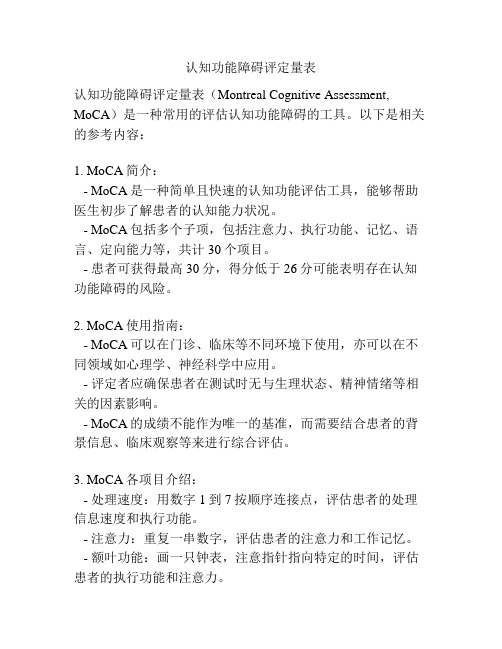
认知功能障碍评定量表认知功能障碍评定量表(Montreal Cognitive Assessment, MoCA)是一种常用的评估认知功能障碍的工具。
以下是相关的参考内容:1. MoCA简介:- MoCA是一种简单且快速的认知功能评估工具,能够帮助医生初步了解患者的认知能力状况。
- MoCA包括多个子项,包括注意力、执行功能、记忆、语言、定向能力等,共计30个项目。
- 患者可获得最高30分,得分低于26分可能表明存在认知功能障碍的风险。
2. MoCA使用指南:- MoCA可以在门诊、临床等不同环境下使用,亦可以在不同领域如心理学、神经科学中应用。
- 评定者应确保患者在测试时无与生理状态、精神情绪等相关的因素影响。
- MoCA的成绩不能作为唯一的基准,而需要结合患者的背景信息、临床观察等来进行综合评估。
3. MoCA各项目介绍:- 处理速度:用数字1到7按顺序连接点,评估患者的处理信息速度和执行功能。
- 注意力:重复一串数字,评估患者的注意力和工作记忆。
- 额叶功能:画一只钟表,注意指针指向特定的时间,评估患者的执行功能和注意力。
- 运动控制:做复杂的手指操纵动作,评估患者的运动协调和执行功能。
- 双任务:记忆五组词,然后进行减法计算,最后回忆之前的词,评估患者的多任务处理能力。
- 记忆:朗读五个词语,然后要求患者在几分钟后回忆这些词语,评估患者的短期记忆。
- 语言:朗读和命名动物,回忆单词,评估患者的语言能力和记忆。
- 定向:询问日期、星期、年份,评估患者的时间和空间定向能力。
4. MoCA的应用:- 在老年人中,MoCA可以评估疾病(如老年性痴呆)对认知功能的影响程度,以及判定是否需要进一步的评估和干预。
- MoCA也可以用于诊断其他认知功能障碍,如轻度认知障碍(MCI)、阿尔茨海默病等。
- 对于脑部疾病或创伤等导致的认知障碍,MoCA能提供客观的评估指标,以便追踪病情变化和干预效果。
5. MoCA的优势和局限性:- 优势:MoCA操作简单,评估时间短,适用范围广,敏感度高,特别适用于评估轻度认知功能障碍。
mmse评分标准 认知功能障碍
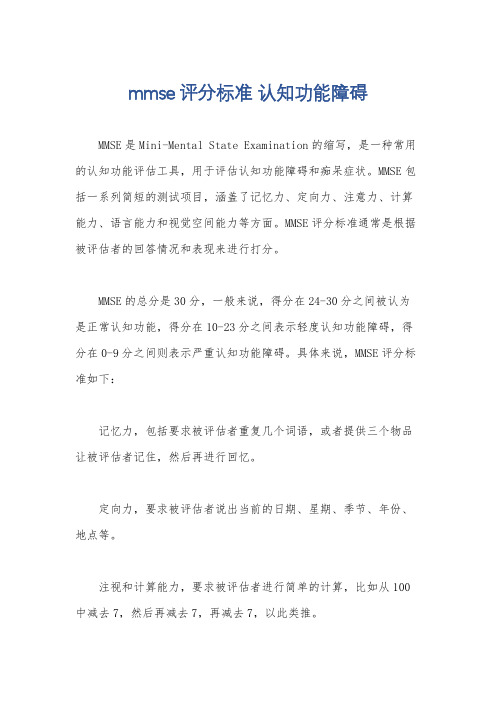
mmse评分标准认知功能障碍
MMSE是Mini-Mental State Examination的缩写,是一种常用的认知功能评估工具,用于评估认知功能障碍和痴呆症状。
MMSE包括一系列简短的测试项目,涵盖了记忆力、定向力、注意力、计算能力、语言能力和视觉空间能力等方面。
MMSE评分标准通常是根据被评估者的回答情况和表现来进行打分。
MMSE的总分是30分,一般来说,得分在24-30分之间被认为是正常认知功能,得分在10-23分之间表示轻度认知功能障碍,得分在0-9分之间则表示严重认知功能障碍。
具体来说,MMSE评分标准如下:
记忆力,包括要求被评估者重复几个词语,或者提供三个物品让被评估者记住,然后再进行回忆。
定向力,要求被评估者说出当前的日期、星期、季节、年份、地点等。
注视和计算能力,要求被评估者进行简单的计算,比如从100中减去7,然后再减去7,再减去7,以此类推。
语言能力,包括命名物品、重复句子、书写句子、阅读和执行指令等。
视觉空间能力,要求被评估者画出指定的图形,比如交叉五线图。
除了以上主要项目,MMSE还包括对被评估者情绪状态和行为的观察。
需要注意的是,MMSE是一种初步的评估工具,评估结果需要综合考虑被评估者的年龄、教育水平等因素来进行解释,同时也需要结合其他临床信息来进行综合判断。
MMSE评分标准是一个相对简单的评估方法,对于更深入的认知功能评估,可能需要结合其他专业的认知功能评估工具和方法。
mmse moca认知障碍和痴呆的标准

mmse moca认知障碍和痴呆的标准
MMSE和MoCA都是用于评估认知功能的工具,以下是它们的认知障碍和痴呆标准:
MMSE(简易智力状态检查量表)的标准:
1. 认知功能障碍:最高得分30分,27-30分正常,分数少于27分考虑为
认知功能障碍。
2. 痴呆的分类标准:文盲≤17分,小学教育≤20分,中学教育(含中专)
≤22分,大学教育(含专科)≤23分。
3. 痴呆严重程度分级:轻度MMSE≥21分,中度MMSE10-20分,重度MMSE≤9分。
MoCA(蒙特利尔认知评估量表)的标准:
一般评定的认知领域有注意力、执行功能、记忆力、语言功能、视结构技能、抽象思维、计算力和定向力。
MoCA量表总分30分,一般大于等于26分
正常,在18~26分之间为轻度认知功能障碍,在10~17分之间为中度,小于10分为重度。
如果接受评定者受教育年限≤12年,一般只在高中水平,结果可加1分,但总分不可超过30分。
需要注意的是,这些标准只是一种参考,具体情况可能因个体差异而有所不同。
在评估认知功能时,医生会综合考虑多个因素,如年龄、教育程度、病史等,以得出准确的诊断。
认知的评估量表

认知的评估量表认知是指人们通过感知、思考、记忆、理解和判断等心理活动来获取和处理信息的能力。
认知的评估量表是一种通过测量和评估个体认知能力的工具,可以帮助评估人的学习、记忆、思维和解决问题等认知功能。
本文将介绍一些常见的认知评估量表以及它们的应用。
1.MMSE(Mini-Mental State Examination)MMSE是一种常见的用于初步评估认知功能的量表,主要用于检测轻度认知障碍或痴呆症的早期症状。
它包括一系列简单的问题和任务,如计算、记忆、命名物品等,以评估个体的注意力、记忆力、语言能力、定向力和执行功能等认知能力。
2.MoCA(Montreal Cognitive Assessment)MoCA是一种针对轻度认知障碍的评估量表,设计用于检测短期记忆、注意力、执行功能、思维灵活性、言语和空间能力等认知能力。
它采用了比MMSE更广泛的认知测量,包括绘图、回忆词语、完成序列等任务,以提供更全面的认知评估。
3.CANTAB(Cambridge Neuropsychological Test Automated Battery)CANTAB是一种计算机化的认知评估工具,通过一系列基于计算机的任务和游戏来测量不同的认知领域。
它包括测试工作记忆、执行功能、注意力、学习和记忆等认知能力。
CANTAB的优势在于它可以提供更精确的量化数据,更好地捕捉认知功能的细微变化。
4.Stroop测试Stroop测试是一种经典的认知测验,用于评估个体的抑制控制能力和注意力。
测试原理是在颜色相关的词语中,以不同颜色的字体呈现其他颜色的词汇,被测试者需要根据字体颜色而非词义进行命名。
该测试基于被试者对注意力的控制和干扰源的处理能力,可以提供一种快速且可靠的方式来评估个体的认知控制能力。
5.Wisconsin Card Sorting Test(WCST)WCST是一种经典的认知测验,用于评估个体的抽象思维和认知灵活性。
MMSE评估

MMSE评估引言概述:MMSE(Mini-Mental State Examination)是一种常用的认知功能评估工具,用于评估患者的认知能力和智力水平。
本文将介绍MMSE评估的背景和意义,并详细阐述其五个主要部份。
一、MMSE评估的目的1.1 评估认知功能:MMSE评估主要用于评估患者的认知功能,包括记忆、注意力、方向力、计算力等方面。
1.2 筛查认知障碍:通过MMSE评估,可以筛查出潜在的认知障碍,匡助医生及早发现和干预认知障碍症状。
1.3 监测病情变化:通过定期进行MMSE评估,可以监测患者认知功能的变化,评估治疗效果和病情发展。
二、MMSE评估的步骤2.1 定向力评估:MMSE评估开始时,首先测试患者的定向力,包括时间、地点和个人信息等。
2.2 记忆力评估:接着,患者需要记住和回顾一系列的词语或者数字,以测试其短期记忆能力。
2.3 注意力和计算力评估:MMSE还包括对患者的注意力和计算力进行评估,例如要求患者倒序计数或者进行简单的数学计算。
三、MMSE评估的得分标准3.1 总分计算:MMSE评估中,每一个测试项目都有相应的分值,根据患者的答题情况进行计分,最后得出总分。
3.2 正常认知功能:总分在24-30分之间被认为是正常的认知功能水平。
3.3 认知障碍风险:总分在18-23分之间可能表示轻度认知障碍,而17分以下则可能表示中度或者重度认知障碍。
四、MMSE评估的局限性4.1 文化和教育差异:MMSE评估的结果受到文化和教育水平的影响,对不同文化背景和教育程度的人可能存在偏差。
4.2 精细认知功能评估:MMSE评估主要关注整体认知功能,对于一些精细认知功能的评估可能不够准确。
4.3 受其他因素干扰:患者的情绪状态、疼痛程度等因素可能对MMSE评估结果产生干扰。
五、MMSE评估的应用领域5.1 神经科学研究:MMSE评估在神经科学研究中被广泛应用,用于研究认知功能的变化和神经退行性疾病的发展。
阿尔茨海默综合症认知功能评估与测试工具

阿尔茨海默综合症认知功能评估与测试工具阿尔茨海默综合症是一种常见的老年痴呆症,其病程通常进展缓慢,但严重影响患者的认知功能,包括记忆力、思维能力和语言表达能力等。
因此,对于阿尔茨海默综合症患者的认知功能进行评估和测试非常重要,有助于早期诊断和制定合适的治疗方案。
一种常用的阿尔茨海默综合症认知功能评估工具是“迷你心理状态检查”,即MMSE(Mini-Mental State Examination)。
MMSE是一种简单、快速且广泛应用的测试工具,包括了11个项目,涵盖了患者的注意力、记忆、定向力和语言等多个方面。
MMSE测试通常由医生或临床心理学家进行,使用标准化的测试问卷。
问卷中的问题有些是连续的,需要患者按照指令进行反应,如计算数学问题或记忆一些事实。
此外,还有一些问题需要患者进行简单的口头回答,例如,被评估者的姓名和当前时间。
除了MMSE之外,还有许多其他常用的阿尔茨海默综合症认知功能评估工具。
例如,蒙特利尔认知评估量表(MoCA)是一种较新的测试工具,具有更高的敏感性,可以检测到患者更早期的认知功能损害。
相比于MMSE,MoCA包括更多的项目,涵盖了记忆、执行功能、定向力、言语和绘画等方面。
此外,还有一些非常规的认知功能评估工具,例如折纸测试和钟表绘制测试。
折纸测试要求患者按照指示将一张纸折叠成特定的形状,评估他们的空间认知和执行功能。
钟表绘制测试则要求患者在给定的纸上绘制一个时钟,并标出指定的时间,用以评估他们的认知和抽象思维能力。
这些评估和测试工具并非单一使用,而是通常结合使用,以获取更全面的认知功能信息。
通过对患者进行全面和系统的评估,医生能够更准确地判断是否存在认知功能损害,并评估其严重程度。
这些评估结果可以帮助医生确定合适的治疗方法和护理计划,以提高阿尔茨海默综合症患者的生活质量。
需要注意的是,认知功能评估和测试并非只针对阿尔茨海默综合症患者。
它们也被广泛用于评估其他类型的认知障碍,如脑损伤、中风和其他神经系统疾病。
标准认知功能评价量表(SCA)

标准认知功能评价量表(SCA)
标准认知功能评价量表(SCA)是一种常用的认知评估工具,
在临床和研究领域广泛应用。
它旨在评估个体认知功能的不同方面,包括记忆、注意力、执行功能等。
测量目的
SCA的主要目的是为了评估个体的认知功能状况。
通过测量不同的认知领域,例如记忆、注意力和执行功能,可以帮助医生或研
究人员了解一个人的认知能力。
这对于早期发现认知障碍、评估治
疗效果以及进行研究都非常重要。
测量内容
SCA包含多个子测试,每个子测试评估不同的认知功能。
其中包括:
- 记忆测试:评估个体的记忆能力,如识别和回忆事物。
- 注意力测试:评估个体的注意力控制和集中能力。
- 执行功能测试:评估个体的认知灵活性、问题解决和决策能
力等。
使用方法
SCA的使用需要专业的训练和资质。
通常由专业医生或研究人员进行评估,并根据测试结果进行分析和解释。
测试过程可能需要一定的时间,以确保准确性和可靠性。
结论
标准认知功能评价量表(SCA)是一种有效的认知评估工具,适用于临床和研究领域。
通过评估个体的认知功能,可以更好地了解其认知能力和状况。
然而,使用SCA需要专业的训练和资质,并且测试结果需要经过专业医生或研究人员进行分析和解释。
常见的认知功能障碍评定方法
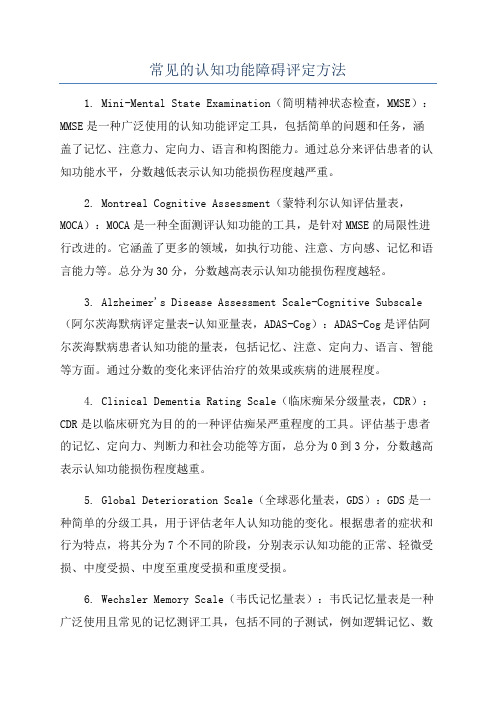
常见的认知功能障碍评定方法1. Mini-Mental State Examination(简明精神状态检查,MMSE):MMSE是一种广泛使用的认知功能评定工具,包括简单的问题和任务,涵盖了记忆、注意力、定向力、语言和构图能力。
通过总分来评估患者的认知功能水平,分数越低表示认知功能损伤程度越严重。
2. Montreal Cognitive Assessment(蒙特利尔认知评估量表,MOCA):MOCA是一种全面测评认知功能的工具,是针对MMSE的局限性进行改进的。
它涵盖了更多的领域,如执行功能、注意、方向感、记忆和语言能力等。
总分为30分,分数越高表示认知功能损伤程度越轻。
3. Alzheimer's Disease Assessment Scale-Cognitive Subscale (阿尔茨海默病评定量表-认知亚量表,ADAS-Cog):ADAS-Cog是评估阿尔茨海默病患者认知功能的量表,包括记忆、注意、定向力、语言、智能等方面。
通过分数的变化来评估治疗的效果或疾病的进展程度。
4. Clinical Dementia Rating Scale(临床痴呆分级量表,CDR):CDR是以临床研究为目的的一种评估痴呆严重程度的工具。
评估基于患者的记忆、定向力、判断力和社会功能等方面,总分为0到3分,分数越高表示认知功能损伤程度越重。
5. Global Deterioration Scale(全球恶化量表,GDS):GDS是一种简单的分级工具,用于评估老年人认知功能的变化。
根据患者的症状和行为特点,将其分为7个不同的阶段,分别表示认知功能的正常、轻微受损、中度受损、中度至重度受损和重度受损。
6. Wechsler Memory Scale(韦氏记忆量表):韦氏记忆量表是一种广泛使用且常见的记忆测评工具,包括不同的子测试,例如逻辑记忆、数字记忆、词汇记忆等。
通过比较患者的测验成绩与正常人群的平均分数,来评估患者的记忆功能是否存在异常。
老年人的认知功能评估及其改善方法

老年人的认知功能评估及其改善方法引言随着全球人口老龄化的加剧,老年人的认知功能评估及其改善方法受到了广泛关注。
认知功能是指个体执行各种心理任务的能力,包括记忆、注意力、思维能力等。
随着年龄的增长,老年人的认知功能可能会出现下降,因此,评估老年人的认知功能,并采取相应的改善措施,对于提高他们的生活质量具有重要意义。
老年人的认知功能评估1. 评估工具评估老年人的认知功能,常用的工具有微型认知评估量表(MMSE)、蒙特利尔认知评估量表(MoCA)等。
这些量表通过一系列简单的心理任务,评估老年人的认知功能,包括记忆、注意力、思维能力等方面。
2. 评估过程评估过程应该由专业的心理医生或护士进行,以确保评估的准确性和一致性。
评估过程中,被评估者需要完成一系列心理任务,如记忆测试、注意力测试等。
评估结果将根据特定的标准进行解读,以判断被评估者的认知功能是否正常。
老年人的认知功能改善方法1. 认知训练认知训练是一种通过有意识的练,提高老年人的认知功能的方法。
包括记忆训练、注意力训练、思维训练等。
认知训练应该是个性化的,根据老年人的具体需要进行。
2. 生活方式的改变健康的生活方式对于改善老年人的认知功能具有重要意义。
包括适量的体育锻炼、均衡的饮食、充足的睡眠、社交活动等。
这些生活方式的改变可以帮助老年人保持良好的认知功能。
3. 药物治疗药物治疗是改善老年人认知功能的一种方法。
一些药物,如胆碱酯酶抑制剂,被用于改善认知功能。
然而,药物治疗需要在医生的指导下进行。
结论老年人的认知功能评估及其改善方法是一个复杂的过程,需要综合考虑个体的具体情况。
评估工具的选择、评估过程的准确性、改善方法的选择等都需要谨慎考虑。
希望通过科学的评估和合理的改善方法,可以提高老年人的生活质量,让他们过上更美好的生活。
认知功能障碍评定方法
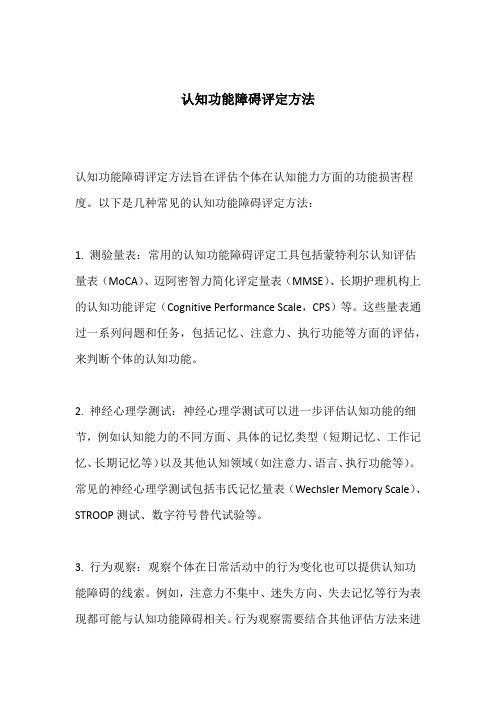
认知功能障碍评定方法
认知功能障碍评定方法旨在评估个体在认知能力方面的功能损害程度。
以下是几种常见的认知功能障碍评定方法:
1. 测验量表:常用的认知功能障碍评定工具包括蒙特利尔认知评估量表(MoCA)、迈阿密智力简化评定量表(MMSE)、长期护理机构上的认知功能评定(Cognitive Performance Scale,CPS)等。
这些量表通过一系列问题和任务,包括记忆、注意力、执行功能等方面的评估,来判断个体的认知功能。
2. 神经心理学测试:神经心理学测试可以进一步评估认知功能的细节,例如认知能力的不同方面、具体的记忆类型(短期记忆、工作记忆、长期记忆等)以及其他认知领域(如注意力、语言、执行功能等)。
常见的神经心理学测试包括韦氏记忆量表(Wechsler Memory Scale)、STROOP测试、数字符号替代试验等。
3. 行为观察:观察个体在日常活动中的行为变化也可以提供认知功能障碍的线索。
例如,注意力不集中、迷失方向、失去记忆等行为表现都可能与认知功能障碍相关。
行为观察需要结合其他评估方法来进
行综合判断。
4. 影像学评估:通过核磁共振成像(MRI)、脑电图(EEG)等技术来观察脑结构和功能的变化。
这些技术可以提供有关认知功能的生理指标,如不同脑区的活动水平、体积变化等。
在评定认知功能障碍时,常见的方法是将上述不同的评估方法结合起来使用。
这样可以综合考虑多个方面的认知功能,提高评定准确性。
此外,评估过程需要由经过训练的医疗专业人员进行,以确保评估的合理性和准确性。
评估结果可以帮助医生和其他相关人员制定适当的干预措施和治疗计划,以改善个体的认知功能和生活质量。
常用的认知功能筛查量表
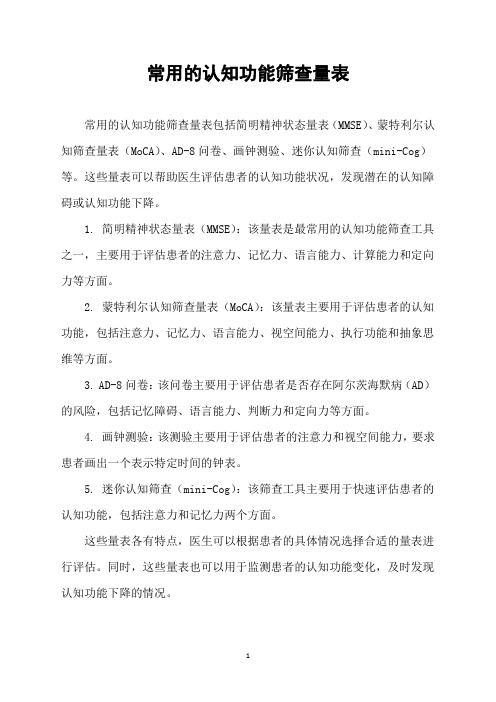
常用的认知功能筛查量表
常用的认知功能筛查量表包括简明精神状态量表(MMSE)、蒙特利尔认知筛查量表(MoCA)、AD-8问卷、画钟测验、迷你认知筛查(mini-Cog)等。
这些量表可以帮助医生评估患者的认知功能状况,发现潜在的认知障碍或认知功能下降。
1. 简明精神状态量表(MMSE):该量表是最常用的认知功能筛查工具之一,主要用于评估患者的注意力、记忆力、语言能力、计算能力和定向力等方面。
2. 蒙特利尔认知筛查量表(MoCA):该量表主要用于评估患者的认知功能,包括注意力、记忆力、语言能力、视空间能力、执行功能和抽象思维等方面。
3. AD-8问卷:该问卷主要用于评估患者是否存在阿尔茨海默病(AD)的风险,包括记忆障碍、语言能力、判断力和定向力等方面。
4. 画钟测验:该测验主要用于评估患者的注意力和视空间能力,要求患者画出一个表示特定时间的钟表。
5. 迷你认知筛查(mini-Cog):该筛查工具主要用于快速评估患者的认知功能,包括注意力和记忆力两个方面。
这些量表各有特点,医生可以根据患者的具体情况选择合适的量表进行评估。
同时,这些量表也可以用于监测患者的认知功能变化,及时发现认知功能下降的情况。
1。
认知功能评估

认知功能评估
认知功能评估是一种通过对个体的认知功能进行评估和测量的方法。
它主要用于评估患有认知障碍、记忆问题或其它认知功能受损的人群,可以帮助医生和护理人员确定个体的认知能力水平,制定适当的治疗和康复计划。
下面我将介绍一些常见的认知功能评估工具和其作用。
1. 麦克纳马拉记忆力测验(MMSE):这是一种常用的评估认知功能的工具,包括指导性问题、记忆力测试、注意力测试等。
通过这一测验,可以评估个体的记忆力、注意力、方向感和计算能力等。
它是检测认知功能障碍和老年性认知障碍(如阿尔茨海默病)的常用工具。
2. 蒙特利尔认知评估量表(MoCA):这是另一种评估认知功
能的广泛使用的工具。
它包括各种认知任务,如记忆力、注意力、执行功能、语言等。
与MMSE相比,MoCA更加敏感,
并能够评估更广泛的认知功能。
3. 威斯康辛卡片分类测验(WCST):这是用来评估执行功能
的方法之一。
它通过要求被试按照不同的原则将卡片分类,以测量其认知灵活性和执行功能。
4. 数字回忆测试(DST):这是一种简单的记忆测试。
被试需要在一定的时间内记住和复述一系列的数字,以评估其短期记忆和工作记忆能力。
5. 爱迪生记忆检查(EMQ):这是一种通过给被试提问一系
列问题来评估其记忆能力的方法。
问题涉及个人身份、生日、家庭情况等。
这种评估方法可以用于评估不同程度的记忆障碍。
通过使用这些评估工具,医生和护理人员可以更准确地评估个体的认知功能,并制定相应的治疗和康复计划。
此外,这些评估工具还可以用于跟踪个体的认知功能变化,评估治疗效果。
简明心理评估状态量表(MMSE)
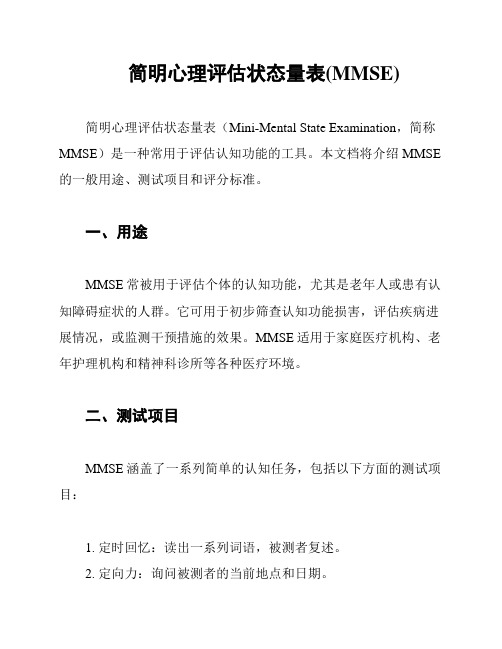
简明心理评估状态量表(MMSE)简明心理评估状态量表(Mini-Mental State Examination,简称MMSE)是一种常用于评估认知功能的工具。
本文档将介绍MMSE 的一般用途、测试项目和评分标准。
一、用途MMSE常被用于评估个体的认知功能,尤其是老年人或患有认知障碍症状的人群。
它可用于初步筛查认知功能损害,评估疾病进展情况,或监测干预措施的效果。
MMSE适用于家庭医疗机构、老年护理机构和精神科诊所等各种医疗环境。
二、测试项目MMSE涵盖了一系列简单的认知任务,包括以下方面的测试项目:1. 定时回忆:读出一系列词语,被测者复述。
2. 定向力:询问被测者的当前地点和日期。
3. 计算能力:进行简单的算术计算。
4. 注释和命名:对一些物体或图形进行命名。
5. 书写任务:要求被测者按指示书写字词或句子。
6. 重复任务:重复给定的短语。
7. 指令执行:根据指示完成特定任务。
8. 定时回忆:再次复述之前提到的词语。
三、评分标准MMSE的评分标准依据被测者的回答情况来判断认知功能的程度。
通常,各个测试项目的回答正确会得到相应的分数。
总分可最高达30分,高分表示认知功能完整,低分则意味着认知功能受损。
在使用MMSE进行评估时,应注意被测者的年龄、教育程度和文化背景对测试结果的影响。
评估人员需要根据特定人群的背景进行适当的解释和修正,以获得更准确的评估结果。
结论简明心理评估状态量表(MMSE)是一种简单且常用的认知功能评估工具。
通过测试项目的有效组合和评分标准的应用,可以快速获得被测者的认知功能水平。
然而,评估过程中需注意因素如年龄、教育程度和文化背景等的影响。
在使用MMSE时,评估人员应综合考虑这些因素,以确保评估结果的准确性和可靠性。
请注意:本文档内容仅供参考,具体使用中请确保根据相关指南和专业要求进行操作。
医院认知功能评估报告书

医院认知功能评估报告书1. 评估目的本次评估旨在了解患者在医院环境中的认知功能状况,以利用评估结果为患者提供适当的照顾和治疗。
通过评估,我们可以确定患者的认知能力水平,以及是否需要额外的支持和关注。
2. 评估方法本次评估采用了以下几种常见的评估工具:2.1 Mini-Mental State Examination (MMSE)MMSE是一种常用的评估认知功能的工具。
该评估包含一系列问题,包括记忆、定向、数学计算和语言能力等方面。
每个问题的得分范围从0到30分,通过总分来衡量患者的整体认知功能状况。
2.2 Clock Drawing Test (CDT)CDT是一种简单有效的评估工具,通过患者绘制一个钟表来评估其认知功能。
通过观察绘制的钟表的特征和错误,可以判断患者的认知功能是否存在问题。
2.3 Digit Span Test (DST)DST是一种测试患者注意力和工作记忆的评估工具。
通过要求患者按照听到的数字序列进行回忆,可以评估其记忆和注意力的水平。
3. 评估结果3.1 MMSE评估结果根据患者完成的MMSE评估,其总分为25分。
根据通常的评分标准,25分表明患者在认知功能方面存在一些轻微问题。
需要进一步观察和检查,确定是否需要提供额外的支持。
3.2 CDT评估结果在绘制钟表的过程中,患者忘记加上刻度,并且时间指针没有正确标注,显示对时间的理解存在问题。
这表明患者的认知功能在理解和处理时间方面可能有一定的困难。
3.3 DST评估结果在DST的回忆环节中,患者只能回忆出5个数字,而不能正确地回忆出更长的数字序列。
这表明患者在注意力和工作记忆方面有一定的问题。
4. 结论与建议综合以上评估结果,可以得出以下结论:- 患者在认知功能方面存在轻度问题。
- 患者对时间理解和处理方面存在困难。
- 患者在注意力和工作记忆方面有一定的问题。
针对以上问题,我们建议:- 提供个性化的认知功能训练,包括通过绘制钟表和数字串联等活动来加强其对时间的理解和处理能力。
MMSE评估

MMSE评估引言概述:MMSE(Mini-Mental State Examination)是一种常用的认知功能评估工具,用于评估患者的认知能力和脑功能状态。
它通过一系列简单而标准化的问题和任务,来评估患者的注意力、记忆、语言、定向力和执行功能等方面。
本文将详细介绍MMSE评估的内容和步骤,以及其在临床实践中的应用。
一、评估内容1.1 注意力和集中力:通过要求患者重复一系列的数字或者字母来测试其注意力和集中力水平。
例如,要求患者按照给定的顺序重复一串数字或者字母,观察患者是否能正确地按照给定的顺序进行回答。
1.2 记忆能力:通过要求患者记住一系列的单词或者物品,并在一段时间后进行回顾来测试其记忆能力。
例如,要求患者记住5个单词或者物品,然后在5分钟后要求患者回顾这些单词或者物品。
1.3 语言能力:通过要求患者进行命名、重复短语或者句子、阅读和书写等任务来测试其语言能力。
例如,要求患者命名一些日常物品,重复一些简单的短语或者句子,阅读一段文字并回答相关问题,以及书写一些简单的词语或者句子。
二、评估步骤2.1 引导和说明:评估开始前,评估者应向患者解释评估的目的和步骤,并获得患者的理解和合作。
2.2 问题和任务:根据评估内容,评估者挨次提问和要求患者完成相应的任务。
评估者应注意患者的回答和表现,并记录相关的结果。
2.3 评估结果:根据患者的回答和表现,评估者将其结果进行评分,并计算总分。
评估者还可以根据不同的问题和任务,对患者在每一个方面的表现进行单独评分。
三、评估结果解读3.1 总分解读:MMSE评估的总分为30分,分数越高表示认知功能越好。
普通来说,总分低于24分可能表明认知功能存在问题,需要进一步的评估和干预。
3.2 各项分数解读:除了总分外,评估者还可以根据各项问题和任务的得分来判断患者在不同方面的认知功能状况。
例如,记忆能力得分低可能提示患者存在记忆问题,语言能力得分低可能提示患者存在语言障碍等。
MMSE评估评分指导

MMSE评估评分指导引言概述:MMSE(Mini-Mental State Examination)是一种常用的认知功能评估工具,用于检测老年人和患有认知障碍的患者的认知能力。
本文将介绍MMSE评估评分的指导,以帮助医务人员正确使用和解读MMSE评估结果。
一、MMSE评估评分的目的1.1 评估认知功能:MMSE评估评分的主要目的是评估患者的认知功能,包括注意力、记忆、定向力、计算能力和语言能力等方面。
1.2 筛查认知障碍:MMSE评估评分可用于筛查认知障碍,早期发现认知功能下降的迹象,有助于及早干预和治疗。
1.3 监测病情变化:通过定期进行MMSE评估评分,可以监测患者认知功能的变化情况,评估治疗效果和病情进展。
二、MMSE评估评分的流程2.1 评估项目:MMSE评估评分包括定向力、注册、注意力与计算、回忆和语言能力五个项目。
2.2 评分标准:每个项目的评分标准不同,根据患者的回答情况,医务人员可以给予相应的分数。
2.3 总分计算:将各项目的分数相加,得出患者的总分,总分范围为0-30分,分数越高表示认知功能越好。
三、MMSE评估评分的注意事项3.1 文化和教育背景:在评估过程中,需要考虑患者的文化和教育背景,避免因为语言或文化差异造成误判。
3.2 评估环境:评估应在安静、无干扰的环境中进行,以确保患者能够集中注意力完成评估。
3.3 评估结果解读:评估结果应结合患者的临床表现和其他辅助检查结果进行综合分析和解读。
四、MMSE评估评分的局限性4.1 年龄和教育影响:MMSE评估评分受年龄和教育水平的影响,老年人和教育程度低的患者可能得分较低,而不一定表示认知功能下降。
4.2 某些认知障碍的检测不敏感:MMSE评估评分对于某些认知障碍,如前额叶功能障碍,可能检测不敏感,需要结合其他评估工具进行综合评估。
4.3 仅供参考:MMSE评估评分结果仅供参考,不能作为诊断认知障碍的唯一依据,还需结合临床症状和其他检查结果进行综合判断。
MMSE评估

MMSE评估MMSE评估是一种常用的认知功能评估工具,用于评估老年人和患有认知障碍的人的认知能力。
本文将详细介绍MMSE评估的标准格式文本,包括评估的目的、评估的步骤和评估结果的解读。
一、评估目的:MMSE评估旨在评估被评估者的认知功能,包括注意力、记忆力、定向力、计算能力、语言能力和视觉空间能力等方面。
通过评估,可以匡助医生判断被评估者是否存在认知障碍,并且可以追踪认知功能的变化。
二、评估步骤:1. 定向力评估:评估者会问被评估者的姓名、年龄、出生地、现在的日期、现在的季节和现在的地点等问题,以评估被评估者的定向力。
2. 凝视和注意力评估:评估者会要求被评估者凝视并重复一串数字或者字母,以评估被评估者的注意力和凝视能力。
3. 记忆力评估:评估者会朗读一串数字或者字母,然后要求被评估者重复。
接着,评估者会朗读另一串数字或者字母,然后要求被评估者按照逆序重复。
通过这一步骤,可以评估被评估者的短期记忆和工作记忆。
4. 语言能力评估:评估者会提供一些物品,要求被评估者命名这些物品,或者要求被评估者重复一些简单的句子。
通过这一步骤,可以评估被评估者的语言能力。
5. 计算能力评估:评估者会提问一些简单的数学问题,如加法或者减法,以评估被评估者的计算能力。
6. 视觉空间能力评估:评估者会提供一些绘图,要求被评估者复制这些绘图或者指出绘图中的错误。
通过这一步骤,可以评估被评估者的视觉空间能力。
三、评估结果解读:MMSE评估的总分为30分,分数越高表示认知功能越好。
普通来说,24分及以上可以认为认知功能正常,18-23分表示轻度认知障碍,10-17分表示中度认知障碍,9分及以下表示重度认知障碍。
除了总分外,MMSE评估还可以根据不同的项目得分来评估不同的认知能力。
例如,定向力、注意力、记忆力、语言能力和计算能力等方面的得分可以提供更详细的认知能力评估信息。
需要注意的是,MMSE评估只是一种初步的评估工具,不能单独用于诊断认知障碍。
- 1、下载文档前请自行甄别文档内容的完整性,平台不提供额外的编辑、内容补充、找答案等附加服务。
- 2、"仅部分预览"的文档,不可在线预览部分如存在完整性等问题,可反馈申请退款(可完整预览的文档不适用该条件!)。
- 3、如文档侵犯您的权益,请联系客服反馈,我们会尽快为您处理(人工客服工作时间:9:00-18:30)。
The National Adult Reading Test (NART)
Purpose – to assess differential deficits across cognitive domains Description – a word recognition reading test using phonologically irregular words – measures information acquired before onset of symptoms – provides percentile scores that allow comparison with other tests – time to administer: 5?0 min
Trail Making A and B
Purpose – to assess motor speed and mental flexibility Description – part A (motor speed) • the subject is shown a piece of paper or a computer screen with the numbers 1?5 located randomly • the task is to join the numbers in ascending order as quickly as possible – part B (set shifting) • as part A but the screen contains both numbers and letters • the task is to connect letters to numbers alternately in ascending order as quickly as possible • assessed as the time to complete each part of the test • time to administer: 5?0 min
Phonological Fluency and Category Fluency (e.g. FAS Test)
Purpose – to assess ability to produce words according to a characteristic (e.g. first letter) Description – the subject is asked to say as many words as possible beginning with a specific letter (usually F, A or S) in 1 min – sometimes specific categories are asked for (e.g. animals) – assessed as the number of correct words – time to administer: 3 min
The values of tests of cognitive function
In patients with schizophrenia, standardised neuropsychological tests can be used to –predict overall functional outcome –assess response to treatment
The Wide Range Achievement Test (WRAT)
Purpose – to determine reading scores compared with years of education before onset of symptoms Description – similar to NART but includes tests of mathematical and spelling skills – has IQ and education equivalent scores and percentile scores – time to administer: 5?0 min
The Conห้องสมุดไป่ตู้inuous Performance Test (CPT)
Purpose – to assess the ability to respond to target stimuli but not to non-target (noise) stimuli Description – the subject is told or shown a target signal to respond to – the subject is presented with a stream of stimuli, 10?0% of which are the target – difficulty can be varied by • degrading the stimuli • making the target more complex (e.g. complex sequences rather than single images) • adding extra simultaneous tasks – assessed as number of missed targets and number of incorrect responses – time to administer: 7?0 min
The Dot Test
Purpose – to assess visuo-spatial memory Description – the subject is allowed to see a sheet with a single dot for a short period – after a delay of 5, 10 or 15 s the subject is asked to show where the dot was – results measured as the average distance between the true and indicated position of the dot – time to administer: 15 min
The California Verbal Learning Test (CVLT)
Purpose – to assess serial learning and recall Description – the subject is given five trials to learn a 16-item list containing items from four conceptual categories (fruits, spices, clothing, tools) – the subject is given a single trial to learn a different list – the subject then has to • recall the first list again • undertake a choice recognition test and identify words from the first list – time to administer: 20 min + 20 min delay
The Letter-Number Span Test
Purpose – to examine the subject抯 ability to retain and perform 抯 low-level categorisation and sequencing of numbers and letters Description – a list of letters and numbers is read to the subject in random order – the subject has to arrange the numbers and letters in ascending order – progressively longer lists are given – results measured by the number of trials successfully completed – time to administer: 20 min
Giessen simple motor mazes
Purpose – to assess visuo-motor coordination Description – the subject has to guide a dot through a maze on a computer screen – the maze has no blind alleys or decision points – the task must be completed as quickly and accurately as possible – assessed as • the length of the route chosen • time to complete • velocity (time relative to the length of route) • errors (number of times the walls are hit) – time to administer: 5?0 min
Rey Auditory Verbal Learning Test (RAVLT)
Purpose – to assess serial learning and delayed recall Description – similar to the CVLT except • word list not conceptually categorised • no prompted recall condition – assessed as • number of words learned over five trials • proportion of information learned immediately that was recalled after a delay (delayed recall) • recognition discrimination – time to administer: 15 min + 20 min delay
